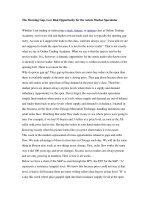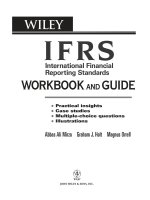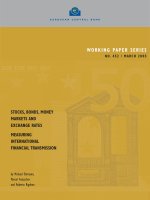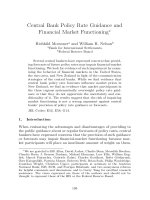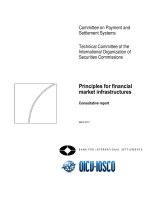Midterm exam for international financial market
Bạn đang xem bản rút gọn của tài liệu. Xem và tải ngay bản đầy đủ của tài liệu tại đây (115.61 KB, 5 trang )
International Financial Market and Korean Economy
CAU MBA
Fall 2015
Name:
ID#:
Midterm Exam
(October 20th, 2015)
Directions : You have 70 minutes to solve the following questions. A correct answer to each question
will earn score as separately noted. Please mark or write your answers on the questions directly.
[Multiple Choices] Each question in this category will give you 5pts.
1. Suppose that a loan made in euros has experienced a capital gain. This indicates that:
A) the dollar appreciated.
B) the dollar depreciated.
C) the euro depreciated.
D) the dollar experienced a capital loss.
2. Governments affect international financial relationships through their institutions. These might
include:
A) border controls regulating goods coming into or leaving from the nation.
B) laws or regulations affecting investment, reserves, or credit.
C) larger sets of rules that define a general context to which specific laws or regulations conform.
D) very broad legal, social, political, and commercial structures that influence economic behavior.
3. In general, when a nation's currency appreciates, goods priced in foreign currencies:
A) become cheaper.
B) become more expensive.
C) are not affected.
D) either become more or less expensive, depending on the value of the currency in that nation.
4. In general, the percentage of appreciation of one nation's currency is equal to:
A) its rate of growth of real GDP.
B) its purchasing power.
C) its population growth.
D) the percentage of depreciation of the foreign nation's currency.
5. Dollarization refers to:
A) increased trade with the United States, resulting in a glut of dollars circulating in the domestic
economy.
B) the fall of the U.S. dollar.
C) the dominance of the U.S. dollar in international finance.
D) the adoption of the U.S. dollar as an official currency by nations outside the United States, such as
El Salvador and Ecuador.
1
International Financial Market and Korean Economy
CAU MBA
Fall 2015
6. An agreement that gives one party the right to buy or sell from or to another party a specified
quantity of currency at a specified price would be included in which of the following transactions?
A) an option
B) a futures contract
C) a forward contract
D) a swap
7. From uncovered interest parity, we know that when the domestic interest rate is greater than the
foreign one:
A) the domestic currency is expected to appreciate.
B) the domestic currency is expected to depreciate.
C) the foreign currency is expected to appreciate.
D) the foreign currency is expected to depreciate.
8. If a euro costs $1.25 today, and it costs $1.50 tomorrow, what has happened to the dollar-euro
exchange rate?
A) The dollar has depreciated and the euro has depreciated.
B) The dollar has appreciated and the euro has depreciated.
C) The dollar has depreciated and the euro has appreciated.
D) The dollar has appreciated and the euro has appreciated.
9. If Europe has a real GDP growth rate of 5%, and the United States has a real GDP growth rate of
6%, while money growth in Europe is 7%, and money growth in the United States is 5%, what would
the monetary exchange rate model predict for exchange rates in the long run?
A) The U.S. dollar would appreciate by 3% against the euro.
B) The U.S. dollar would depreciate by 3% against the euro.
C) The U.S. dollar and the euro would not change against each other because the growth rates are
offsetting.
D) The U.S. dollar would appreciate by 1% against the euro.
10. Money can be defined as:
A) a unit of account.
B) a store of value.
C) a medium of exchange.
D) a unit of account, a store of value, and a medium of exchange.
11. If prices are held constant and income increases by 12%, the demand for money will ______ by
_______%.
A) decrease; 21
B) increase; 12
C) decrease; 12
D) remain unchanged
12. According to the quantity theory of money, the demand for money is equal to:
A) nominal income divided by real income.
B) a constant proportion of nominal income.
C) the demand for money held as an asset.
2
International Financial Market and Korean Economy
CAU MBA
Fall 2015
D) real income divided by velocity.
13. The price level in the country is determined by ______ and _______.
A) nominal money supply; demand for real money
B) demand for real money; average tax rate
C) demand for real money; growth of GDP
D) supply of real money; demand for real money
14. Using the asset model of short-run exchange rate determination, once the domestic rate of return is
determined by MS and MD, the short-run equilibrium _____ can be determined if prices are inflexible
and expectations are given.
A) interest rate
B) exchange rate
C) price level
D) income level
15. In the short run, the nominal interest rate is affected by changes in the money supply perceived to
be temporary, but once ____ adjust(s), the nominal interest rate ____ in the long run.
A) the supply of money; rises
B) the price level; will revert to its former level
C) expectations of interest rates; falls
D) real GDP; does not change
16. The monetary approach basically looks at ____ as the fundamental variable affecting _____
exchange rates.
A) interest rates; short-run
B) interest rates; long-run
C) the price level; short-run
D) the price level; long-run
17. When there is a permanent fall in the foreign money supply, the exchange rate:
A) falls in the short run and rises slightly in the long run.
B) falls in the short run and falls more in the long run.
C) rises in the short run and falls slightly in the long run.
D) rises in the short run and rises more in the long run.
18. If UIP holds and the home currency is expected to appreciate by 4%, then the home interest rate
is:
A) 6%.
B) 5%.
C) 4%.
D) Not enough information is provided.
19. Aggressive policy measures taken by the monetary authority during the 2007-2008 financial crisis
in the United States resulted in:
A) avoidance of a recession caused by a tight credit market.
3
International Financial Market and Korean Economy
CAU MBA
Fall 2015
B) almost no transmission of the monetary stimulus to market rates of interest, increased lending, and
expansion of GDP.
C) lower rates of interest and increased investment activity.
D) an increase of real GDP and a fall in the core unemployment rate.
20. When the exchange rate has fallen in the short run and then rises to its original level in the long
run, it implies that:
A) the domestic money supply has temporarily risen.
B) the domestic money supply has permanently risen.
C) the domestic money supply has temporarily fallen.
D) the domestic money supply has permanently fallen.
[Essay Questions] Each question or sub-question here will give you points as noted.
21. (2 pts per cell)The following table summarizes the effects of changes in economic policies or
parameters in the short-run. Fill in the blanks. You may choose your answer among the following:
Right, Left, No change.
IS curve
LM curve
∆𝐆𝐆 > 0
right
No Change
left
No change
∆𝐌𝐌 > 0
No change
right
∆𝐓𝐓 > 0
22. (10 pts) Comparing the examples of Denmark and the United Kingdom in relationship to the
European Monetary Union, the krone is pegged to the euro, whereas the British pound is not. What
could be predicted about their interest rates?
The United Kingdom has the ability to set its own interest rates and pursue an independent
monetary policy, whereas Denmark's rates are virtually the same as those of the euro.
23. (10pts) Assume sticky prices and given expectations of future exchange rates, what is the immediate
effect on the exchange rate of the U.S. dollar (purchasing euros) if there is a temporary increase in the
quantity of U.S. dollars?
U.S. nominal and real returns rates decline while euro rates hold steady, and the U.S. dollar
depreciates against the euro.
24. Suppose there are two countries in the globe-A and B. The official currencies of country A and B
are called Corvette and Diablo. As of today, the exchange rate between these two currencies is formed
at the level of 1 Corvette=1 Diablo. The two countries adopt the floating exchange rate regime. Consider
4
International Financial Market and Korean Economy
CAU MBA
Fall 2015
a risk neutral investor in Country A. He is informed that the exchange rate tomorrow will be doubled
with probability of 1/2 or will be halved with probability of 1/2. The official definition of exchange rate
is E = the unit(s) of Diablo traded for 1 unit of Corvette.
In these circumstances, it occurrs to the risk neutral investor that the expected payoff from investing
in Diablo and cashing it back tomorrow will be greater than the expected payoff from investing in
Corvette for the following reason: when the exchange rate is halved, the investor will receive 2 corvette
for the initial investment of 1 corvette. On the other hand, when the exchange rate is doubled, the
investor will receive 1/2 corvette. Summing up, 1/2*2 corvette+1/2*0.5 corvette=1.25>1.
(1)
Assume that in this world economy PPP holds perfectly. Then, evaluate this reasoning of the
risk neutral investor. (10pts)
Answer) Under the dominance of PPP, the uncertainty described above implies that the price level
of country A is doubled or halved with probability of 1/2 each. So, as an investor in A, if he converts
1 corvette into 1 diablo and keeps it, he will get the nominal return as mentioned in the above.
However, if we measure his gains and losses in physical goods (or in real terms), we will see that he
will not gain anything.
(i) 2 corvettes are obtained when the price level is doubled. So his purchasing power will be the
same as before.
(ii) 1/2 corvette means the price level is halved. Hence, no changes in his purchasing power.
(2)
Consider that there is another risk neutral investor in country B. What will he think about
the future exchange rate movement (he is equally informed just like his counterpart in
country A)? Will he consider it favorable or unfavorable? (10pts)
Answer) Same as in (1).
(3)
Now disregard the assumption that PPP holds. Instead suppose there are non-tradable
commodities or services across the countries. Then, how will your answer to (i) change?
(10pts) (hint: try to use the interest parity condition.)
Answer) Since there are non-tradable goods, the determination of the exchange rate will not follow
the PPP condition and instead the interest parity condition will hold. Accordingly, the interest rate
differential between the two countries will move in accordance with the exchange rate change so that
it may make up for the exchange rate differential in each realization of the uncertainty. To rephrase,
by changing Corvettes with Diablos the investor may get gains from exchange rate movement while
losing interest rate income.
5

